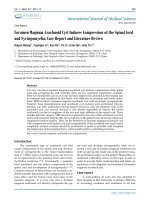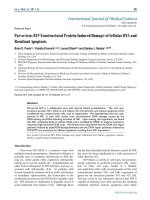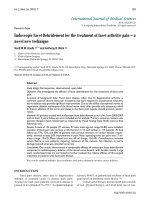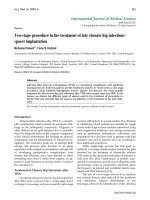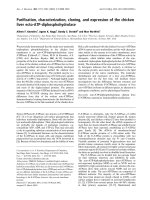Báo cáo y học: "Pravastatin Provides Antioxidant Activity and Protection of Erythrocytes Loaded Primaqe"
Bạn đang xem bản rút gọn của tài liệu. Xem và tải ngay bản đầy đủ của tài liệu tại đây (498.43 KB, 8 trang )
Int. J. Med. Sci. 2010, 7
358
I
I
n
n
t
t
e
e
r
r
n
n
a
a
t
t
i
i
o
o
n
n
a
a
l
l
J
J
o
o
u
u
r
r
n
n
a
a
l
l
o
o
f
f
M
M
e
e
d
d
i
i
c
c
a
a
l
l
S
S
c
c
i
i
e
e
n
n
c
c
e
e
s
s
2010; 7(6):358-365
© Ivyspring International Publisher. All rights reserved
Research Paper
Pravastatin Provides Antioxidant Activity and Protection of Erythrocytes
Loaded Primaquine
Fars K. Alanazi
1,2
1. Kayyali Chair for Pharmaceutical Industry, Department of Pharmaceutics, College of Pharmacy, King Saud University,
P.O. Box 2457, Riyadh 11451, Saudi Arabia.
2. Center of Excellence in Biotechnology Research, King Saud University, P.O. Box 2460, Riyadh, 11451, Saudi Arabia.
Corresponding author: Email:
Received: 2010.09.02; Accepted: 2010.10.27; Published: 2010.10.28
Abstract
Loading erythrocytes with Primaquine (PQ) is advantageous. H o w e v e r , P Q p r o d u c e s d a m a g e
to erythrocytes through free radicals production. Statins have antioxidant action and are
involved in protective effect against situation of oxidative stress. Thus the protective effect of
pravastatin (PS) against PQ induced oxidative damage to human erythrocytes was investigated
in the current studies upon loading to erythrocytes.
The erythrocytes were classified into; control erythrocytes, erythrocytes incubated with
either 2 mM of PS or 2 mM of PQ, and erythrocytes incubated with combination of PS plus
PQ. After incubation for 30 min, the effect of the drugs on erythrocytes hemolysis as well as
some biomarkers of oxidative stress (none protein thiols, protein carbonyl, thiobarbituric
acid reactive substance) were investigated.
Our results revealed that PS maintains these biomarkers at values similar to that of control
ones. On the other hand, PQ cause significant increases of protein carbonyl by 115% and
thiobarbituric acid reactive substance by 225% while non-protein thiols were significantly
d e c r e a s e d b y 1 1 2 % c o m p a r e d w i t h c o n t r o l e r y t h r o c y t e s . P S p r e -incubation before PQ exerts
marked reduction of these markers in comparison with PQ alone. Moreover, at NaCl con-
centrations between 0.4% and 0.8%, PQ causes significant increase o f R e d B l o o d C e l l s ( R B C s )
hemolysis in comparison with the other groups (P<0. 001). Scanning electron micrograph
indicates spherocytes formation by PQ incubation, but in the other groups the discocyte
shape of erythrocytes was preserved.
The reduction of protein oxidation and lipids peroxidation by PS is related to antioxidants
e f f e c t o f t h i s s t a t i n . P r e s e r v a t i o n o f e r y t h r o c y t e s f r a g i l i t y a n d m o r p h o l o g y b y P S a r e r e l a t e d t o
i t s f r e e r a d i c a l s s c a v e n g i n g e f f e c t . I t i s c o n c l u d e d t h a t p r a v a s t a t i n h a s p r o t e c t ive effect against
erythrocytes dysfunction related any situations associated with increased oxidative stress,
especially when loaded with PQ.
Key words: Erythrocytes, Drug delivery, Pravastatin, Primaquine, Oxidative Stress.
Introduction
Erythrocytes as drug delivery systems (DDS's)
are exposed to several stress situations. This stress
may be either physical, hyperosmotic, as well as
oxidative stress [1]. The erythrocytes membrane is
protected from oxidative damages by antioxidant
enzymes system such as superoxide dismutase, cata-
lase, and glutathione peroxidase in addition to non
enzymatic systems such as glutathione, vitamins A, C
and E [2]. The alteration of these protective mechan-
isms may result in increase of free radicals production
that alters the cellular functions [3].
Int. J. Med. Sci. 2010, 7
359
RBCs are frequently exposed to oxygen when
l o a d e d w i t h d r u g s a s D D S ' s , t h u s a r e m o r e s u s c e p t i b l e
to oxidative damage. Moreover, the hemoglobin in
RBCs is a strong catalyst that may initiate oxidative
damage [4]. Oxidation of erythrocytes leads to signif-
icant alterations in their structural lipids as well as
deformations of the cytoskeletal proteins [5]. In addi-
tion to lipid peroxidation, sulfhydryl groups of pro-
teins may be targeted for oxidative stress [4]. Fur-
thermore, the decrease of glutathione can enhance the
tendency of sulfhydryl groups to oxidation [5]. Oxi-
dation of proteins increases the formation of disulfide
as well as carbonyl groups [6].
Toxic manifestations induced by several drugs
are shown to be mediated by oxidative stress me-
chanisms. Involvement of reactive oxygen species
(ROS) has been demonstrated in the toxicity of many
drugs to erythrocytes [7]. PQ is used for treatment of
malarial infections and its loading to erythrocytes is
useful. The therapeutic use of this drug is restricted
due to its toxic side effects. PQ causes hemolytic
anemia especially in glucose-6-phosphate dehydro-
genase deficient patients [8]. The interaction between
PQ with reduced nicotinamide dinucleotide phos-
phate (NADPH) underlies many aspects of PQ toxic-
ity. Also, the autooxidation of PQ result in formation
of ROS which leading to oxidative alterations in eryt-
hrocytes [9]. These species not only overwhelm cellu-
lar antioxidant defenses but also attack cellular
structural molecules, leading to oxidative modifica-
tion of erythrocytes [10].
Antioxidants can help in preservation of an
adequate antioxidant status; therefore, they preserve
the normal physiological function of living cells by
protection against reactive oxygen species [11]. Statins
are the group of drugs that lower the blood choles-
terol level, besides their therapeutic uses of hyperli-
pidemia, inflammation, immunomodulation in addi-
tion to antioxidant effects [12, 13]. Pravastatin (PS) is
one of the statins group effective in the treatment of
hypercholesterolemia. Moreover, it has other benefi-
cial effects on several cardiovascular alterations [14].
Previously the study demonstrated that treatment
with PS has protective effect against oxidative stress
[15].
The present study was designed to demonstrate
the protective effect of PS against PQ induced lipids
peroxidation, proteins oxidation as well as hemolysis
of human erythrocytes upon loading. The erythro-
cytes are incubated with PQ for 30 min and its effect
on erythrocytes thiobarbituric acid reactive substance
(TBARS), protein carbonyl (PCO) as well as
non-protein thiols (NPSH) is determined in presence
and absence of PS.
Materials and methods
Materials
Pravastatin sodium was gifted by Saudi Phar-
maceutical Industries & Medical Appliances Corpo-
ration (SPIMACO, Al–Qassim, Saudi Arabia). P r i-
maquine diphosphate, Ellman’s reagent and thiobar-
bituric acid, tetraethoxypropane were provided by
Sigma Chemical Co., St. Louis, MO, USA. Acetonitrile,
methanol, isopropanol, trichloroacetic acid and so-
dium hydroxide were supplied by Merck Germany.
2,4–Dinitrophenylhydrazine and, Guanidine hy-
drochloride were obtained from (BDH Chemical Ltd
Poole UK, and Winlab, UK respectively.
All of the
remaining chemicals used in the studies are
commercially available as analytical grade.
Instrumentation
S p e c t r o U V -Vis Split Beam PC (Model UVS-2800,
Labomed, Inc.); Shaking Water Bath (Julabo SW22);
Centrifuge CT5 were used for the investigation of the
present studies and COULTER
®
LH 780 is used as
Hematology Analyzer.
Specimen collection and erythrocytes isolation
Blood samples were collected in heparinized
tubes from adult men (ages between 35-40 years) not
suffered from chronic or acute illness. Informed con-
sent was obtained from all donors. The blood was
centrifuged for 5 min at 1500 rpm. The plasma and
buffy coat were removed by aspiration to eliminate
leucocytes and platelets; erythrocytes were washed
three times in cold phosphate buffer saline pH 7.4
with centrifugation for 5 min at 1500 rpm [16]. This
study was approved by the research center ethics
committee of College of Pharmacy, King Saud Uni-
versity, Riyadh, Saudi Arabia.
Experimental design
Erythrocytes suspension with hematocrite ad-
j u s t e d a t 4 5 % w e r e c l a s s i f i e d i n t o 4 g r o u p s w h e r e e a c h
group contains 6 samples: in group one the erythro-
cytes exposed neither pravastatin nor primaquine
(control group). In the second group, the erythrocytes
were incubated with 2mM of pravastatin. The eryt-
hrocytes were treated with 2mM of primaquine in the
third group. And in the fourth group the erythrocytes
were exposed to pravastatin plus primaquine 2mM.
After 30 min, the erythrocytes were hemolysed by
adding distilled water (1:1). Then the lysates were
used for the following biochemical investigations.
Assessment of erythrocytes non-protein thiols status
Erythrocytes NPSH were determined using
Ellman’s reagent, 5, 5-dithiobis (2- nitrobenzoate).
Int. J. Med. Sci. 2010, 7
360
Protein was precipitated with adding 1:1 volume of
5% trichloroacetic acid (TCA). After centrifugation,
the supernatant was neutralized with Tris-NaOH and
NPSH were quantified in supernatant [17].
Assessment of erythrocytes protein oxidation
Protein oxidation erythrocytes were assayed as
protein carbonyl according to the method of Levine et
al. [18]. Proteins were precipitated from RBCs lysates
by addition of 10% TCA and resuspended in 1.0 ml of
2 M HCl for blank and 2 M HCl containing 2% 2,4-
dinitrophenyl hydrazine. After incubation for 1 h at
37°C, protein samples were washed with alcohol and
ethyl acetate, and re-precipitated by addition of 10%
TCA. The precipitated protein was dissolved in 6 M
guanidine hydrochloride solution and measured at
370 nm. Calculations were made using the molar ex-
tinction coefficient of 22×103M
−1
cm
−1
and expressed
as nmol carbonyls formed per mg protein. Total pro-
tein in RBC pellet was assayed according to the me-
thod of Lowry et al. [19] using bovine serum albumin
as standard.
Assessment of erythrocytes lipids peroxidation
Thiobarbituric acid reactive substance (TBARS)
was determined as indicator of lipid peroxidation in
erythrocytes by a spectrophotometric method [20]. A
mixture of 200 μL of 8% sodium dodecyl sulfate, 200
μL of 0.9% thiobarbituric acid and 1.5 ml 20% acetic
acid was prepared. 200 μL of RBCs lysate and 1.9 ml
distilled water were added to complete the volume of
4 ml. After boiling for 1 h, the mixture was cooled,
a n d 5 m l o f n-b u t a n o l a n d p y r i d i n e ( 1 5 : 1 ) s o l u t i o n w a s
added to it. This mixture was then centrifuged at 5000
rpm for 15 min and the absorbance was measured at
532 nm. Quantification of MDA levels was performed
using tetraethoxypropane as the standard.
Determination of erythrocytes hemolysis
Erythrocytes hemolysis was determined by os-
motic fragility behavior using different NaCl solu-
tions. A 25 μL of blood samples from all studied
groups were added to a series of 2.5 ml saline solu-
tions (0.0 to 0.9 % of NaCl). After gentle mixing and
standing for 15 min at room temperature the eryt-
hrocytes suspensions were centrifuged at 1500 rpm for
5 min. The absorbance of released hemoglobin into
the supernatant was measured at 540 nm [21].
Scanning electron microscopy (SEM)
Morphological differences between control and
drug exposed erythrocytes was evaluated using JEOL
JSM-6380 LA. Scanning electron microscope was used
to evaluate the morphological differences between
normal, pravastatin and primaquine exposed eryt-
hrocytes. All groups of erythrocytes were fixed in
buffered gluteraldehyde. Aldehyde was drained and
rinsed 3 times each of 5 min in phosphate buffer and
post-fixed in osmium tetroxide for 1 h. After this, the
samples were rinsed in distilled water and then de-
hydrated using a graded ethanol series; 25, 50, 75, 100
and another 100% each for 10 min. Then the samples
were rinsed in water, removed, mounted on stabs,
coated with gold and viewed under the SEM.
Statistical analysis
The statistical differences between groups were
analyzed by one way ANOVA followed by TUKEY
Kramer multiple comparison test, using GraphPad
Prism Software v 5.01. The values at P < 0.05 were
chosen as statistically significant.
Results
Our results revealed that incubation of erythro-
cytes for 30 min with pravastatin at concentration
2mM do not change the NPSH level in erythrocytes
(57.13 ± 6.50) versus erythrocytes free drug (58.93 ±
4.81). While exposure of erythrocytes to 2 mM pri-
maquine alone was resulted in a significant decrease
of NPSH content (26.05 ± 2.58) compared with control
erythrocytes as well as pravastatin exposed erythro-
cytes. Pretreatment of erythrocytes with 2mM of
pravastatin before primaquine exposure preserve
NPSH level (54.03 ± 4.84) regarding to RBCs incu-
bated with PQ alone, Figure 1.
In this study, there is considerable elevation of
PCO content of erythrocytes treated with 2mM of
primaquine by about 115% in relation to either control
erythrocytes or erythrocytes treated with pravastatin.
On the other hand, erythrocytes treated with 2mM of
pravastatin exert no change in PCO level in relation to
control one. Moreover, prior incubation of erythro-
cytes with pravastatin keep away from primaquine
induced elevation of PCO content by about 113%, see
Figure 2.
In respect to TBARS our results showed that in-
cubation of erythrocytes with PQ exert significant
elevation of TBARS by about 225% versus erythro-
cytes free drug as well as erythrocytes supplemented
with pravastatin. Furthermore, pravastatin treatment
at the same time with primaquine preserves the eryt -
hrocytes TBARS content at value near that of the con-
trol group see Figure 3.
Hemolysis profile of control erythrocytes and
erythrocytes incubated with pravastatin, primaquine
alone or in combination is revealed in Table 1. The
results of this work demonstrated that, NaCl at 0-0.2%
concentration range, there is no significant difference
in the erythrocytes hemolysis in percent between
Int. J. Med. Sci. 2010, 7
361
primaquine, pravastatin as well as control erythro-
cytes. Conversely, NaCl at 0.3-0.9% concentration
range, there is significant increase in the percent of
RBCs hemolysis for primaquine in comparison with
the other groups (P<0. 001).
Table 1: Hemolysis profile of control erythrocytes and
erythrocytes exposed to either PRV or PQ at concentra-
tion 2 m mole /L
NaCl g/L % of erythrocytes hemolysis
Control PS PQ PS+ PQ
1.0 94.8 ± 9.24 98.4 ± 8.65 99.5 ± 8.03 95.2 ± 9.63
2.0 88.2 ± 8.70 89.2 ± 9.53 97.9 ± 6.05 90.2 ± 7.63
3.0 62.8 ± 14.3 63.2 ± 10.8 83.5 ± 12.5
*a
64.4 ± 8.50
*b
4.0 27.8 ± 5.16 31.3 ± 7.64 51.5 ± 13.3
**a
37.3 ± 6.43
*b
5.0 21.3 ± 7.50 22.3 ± 9.49 40.6 ±
8.71
a
23.8 ± 9.82
*b
6.0 11.7 ± 3.39 12.9 ±3.28 27.4 ± 6.34
***a
14.2 ± 2.00
***b
7.0 5.18 ± 1.90 6.79 ±2.22 16.2 ± 3.61
***a
9.05 ± 2.00
***b
8.0 2.88± 1.78 2.51 ± 0.86 9.07 ± 2.60
***a
3.96±1.54
***b
9.0 1.28 ± 0.55 1.42± 1.01 2.76 ± 1.04
*a
2.28 ±0.85
Data expressed as mean ± SD, six samples in each group
a, significantly increased from control or pravastatin (PS)
b, significantly decreased from primaquine (PQ)
*
, P value ≤ 0.05
**
, P value ≤ 0.01
***
, P value ≤ 0.05
In this study, our data also show that the mini-
mum hemolysis of erythrocytes (1.28%, 1.42%, 2.76 %
and 2.28%) was observed at NaCl concentration of 0.9
% for control, pravastatin, primaquine and their
combinations respectively. On another side the
maximum hemolysis of 94.8% for control erythro-
cytes, 98.4% for pravastatin, 99.5% for primaquine
and 95.2% for the combination between pravastatin
and primaquine was occurred at NaCl concentration
of 0.1%.
Typical micrographs of erythrocytes obtained
following exposure to drugs has been depicted in
Figure 4. Control erythrocytes and erythrocytes in-
cubated (for 30 min) with pravastatin, primaquine, as
well as their combinations at 2 mM concentrations
were screened for any observable morphological al-
terations using scanning electron microscope (SEM).
Our results showed the spherocytes formation as a
result of primaquine incubation. But in control group,
pravastatin as well as pravastatin plus primaquine
treatment showed the normal discocyte shape of
erythrocytes was preserved.
Figure 1: Effect of pravastatin and primaquine on erythrocytes non protein thiols (NPSH) level.
Int. J. Med. Sci. 2010, 7
362
Figure 2: Effect of pravastatin and primaquine on erythrocytes protein carbonyl level.
Figure 3: Effect of pravastatin and primaquine on erythrocytes thiobarbituric acid reactive substance (TBARS) level.


